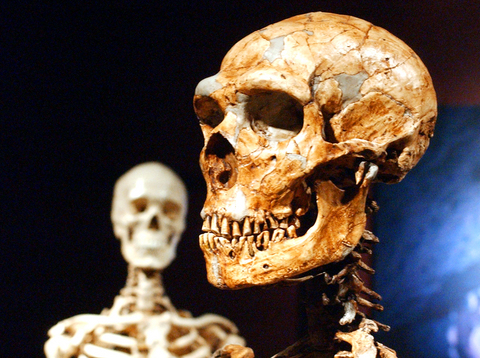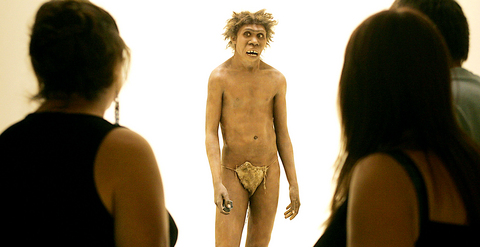The final resting place of the last Neanderthals may have been unearthed by fossil-hunters excavating deep inside a cave in Gibraltar.
Primitive stone tools and remnants from wood fires recovered from the vast Gorham's cave on the easternmost face of the Rock suggest Neanderthals found refuge there, and clung to life for thousands of years after they had died out elsewhere.
Carbon dating of charcoal fragments excavated alongside spear points and basic cutting tools indicates the cave was home to a group of around 15 Neanderthals at least 28,000 years ago, and possibly as recently as 24,000 years ago. Previously uncovered remains lead scientists to believe the Neanderthals died out in Europe and elsewhere some 35,000 years ago.

PHOTOS: AFP
The discovery marks more clearly than ever before the time of death of our closest relative, and completes one of the most dramatic chapters in human evolution.
Today, Gorham's cave is perched on a cliff face lapped by the Mediterranean, but the view from the east-facing entrance was once of rolling sand dunes pocked with vegetation. A freshwater stream running down from the north led to the sea 4.8km away.
“For the Neanderthals, this was a great place to be. The view would have been breathtaking, and they would have literally been able to see where their next meal was coming from,” said Chris Stringer, a scientist on the project at the Natural History Museum in London. “The evidence supports the idea that this was one of their last survival spots, one of their final outposts.”

The sea level was around 100m lower in Neanderthal times as vast quantities of water were locked up in glaciers that encroached from the poles and smothered Scotland in sheets of ice 3.2km thick.
Clive Finlayson at the Gibraltar Museum said the Neanderthals probably survived in the region because of the stabilizing influence of the Atlantic on the local climate.
Elsewhere, glaciation caused violent lurches in climate that turned fertile pastures into barren wastelands.
But at Gorham's cave, and along the nearby coast, the climate would have been calmer, maintaining what Finlayson calls a “Mediterranean Serengeti,” with red deer, leopards and hyenas roaming between watering holes.
The discovery throws into doubt the theory that the arrival of modern humans was solely responsible for the demise of the Neanderthals, by outcompeting them for food or even engaging in the earliest acts of genocide. More likely, the Neanderthals were already struggling to adapt to rapid changes in crucial food resources such as vegetation and wild animals.
Modern humans and Neanderthals split from a common ancestor, Homo heidelbergensis, around 500,000 years ago when the power of fire was first harnessed.
From a foothold north of the Mediterranean, Homo heidelbergensis steadily evolved into the Neanderthals, while in Africa, the same species embarked on a different evolutionary path, one that ultimately gave rise to modern-day Homo sapiens. Remains of Neanderthals dating back as far as 400,000 years suggest a reasonably sophisticated species which crafted handtools and weapons and buried its dead.
The stone tools unearthed from Gorham's cave were discovered 2.5m beneath the soil towards the back of the 40m long cave where the Neanderthals had created a hearth. The collection includes basic knife edges used for butchering carcasses and scraping tools for working skins and hides, according to the journal Nature.
Many of the tools were preserved impeccably. “I saw one flake and went to touch it, knowing it was a tool left by a Neanderthal, and it drew blood,” said Finlayson. “It can be very powerful being in the cave. You can get that feeling that a Neanderthal was sitting in exactly the same spot, that the only thing separating us is time.”
Neanderthals explained
The neanderthals were short and powerfully-built, with huge noses and receding foreheads, but there is no evidence that they had less brainpower than modern humans. Their brains were at least as big as ours, although there were differences: the frontal lobes were smaller, suggesting they may not have been as adept at planning, while the rear of the brain was larger, suggesting keener sight than modern humans.
Many scientists believe their stocky stature was chiefly an adaptation to the cold, a useful trait considering they lived through the last Ice Age. Being squat reduces a creature's surface area, and so less heat is lost from the body.
Climate may have played only a part though. Some scientists believe the Neanderthal's squat form favored their lifestyle, of limited roaming with regular and physical wrestles with the animals that would become their prey.
The spear points and cutting edges unearthed in Gorham's cave in Gibraltar are known as Mousterian tools, named after the Le Moustier site in Dordogne, where the best examples of neanderthal archeaology were first uncovered.
Gibraltar has proved a treasure trove for modern neanderthal hunters. The first neanderthal bones discovered were those of a woman, found in a quarry in Gibraltar in 1848. And in 1997, archaeologists working in a cave on the Rock discovered the remains of what they believe was a neanderthal meal of mussels, pistachio and tortoise cooked up more than 30,000 years ago.
More recent findings have suggested neanderthals brought shellfish and other food to their caves before crafting simple tools to break them apart and prepare them.

April 14 to April 20 In March 1947, Sising Katadrepan urged the government to drop the “high mountain people” (高山族) designation for Indigenous Taiwanese and refer to them as “Taiwan people” (台灣族). He considered the term derogatory, arguing that it made them sound like animals. The Taiwan Provincial Government agreed to stop using the term, stating that Indigenous Taiwanese suffered all sorts of discrimination and oppression under the Japanese and were forced to live in the mountains as outsiders to society. Now, under the new regime, they would be seen as equals, thus they should be henceforth

Last week, the the National Immigration Agency (NIA) told the legislature that more than 10,000 naturalized Taiwanese citizens from the People’s Republic of China (PRC) risked having their citizenship revoked if they failed to provide proof that they had renounced their Chinese household registration within the next three months. Renunciation is required under the Act Governing Relations Between the People of the Taiwan Area and the Mainland Area (臺灣地區與大陸地區人民關係條例), as amended in 2004, though it was only a legal requirement after 2000. Prior to that, it had been only an administrative requirement since the Nationality Act (國籍法) was established in

With over 80 works on display, this is Louise Bourgeois’ first solo show in Taiwan. Visitors are invited to traverse her world of love and hate, vengeance and acceptance, trauma and reconciliation. Dominating the entrance, the nine-foot-tall Crouching Spider (2003) greets visitors. The creature looms behind the glass facade, symbolic protector and gatekeeper to the intimate journey ahead. Bourgeois, best known for her giant spider sculptures, is one of the most influential artist of the twentieth century. Blending vulnerability and defiance through themes of sexuality, trauma and identity, her work reshaped the landscape of contemporary art with fearless honesty. “People are influenced by

Three big changes have transformed the landscape of Taiwan’s local patronage factions: Increasing Democratic Progressive Party (DPP) involvement, rising new factions and the Chinese Nationalist Party’s (KMT) significantly weakened control. GREEN FACTIONS It is said that “south of the Zhuoshui River (濁水溪), there is no blue-green divide,” meaning that from Yunlin County south there is no difference between KMT and DPP politicians. This is not always true, but there is more than a grain of truth to it. Traditionally, DPP factions are viewed as national entities, with their primary function to secure plum positions in the party and government. This is not unusual